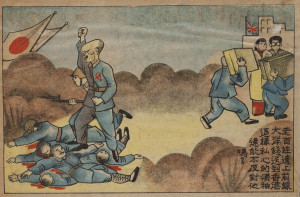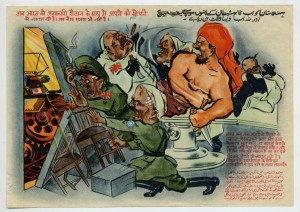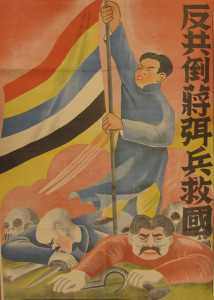‘Enemy of the People’
- By Peter Harmsen
- 2 August, 2013
- 20 Comments

Chiang Kai-shek, China’s most important leader during the long war with Japan in the 1930s and 1940s, was different things to different people. While he was often portrayed in the west as a champion of the Allied cause, he was just as frequently vilified closer to home by his foes. The visual arts were among the ways this vilification manifested itself. Jeremy E. Taylor, associate professor at Nottingham University’s School of Contemporary Chinese Studies, is behind an ambitious project to document the visual depictions of Chiang Kai-shek and introduces the subject in this article first carried by the university’s China Policy Institute Blog:
Academic interest in Chinese propaganda is nothing new. Propaganda posters, particularly those dating from the years of the Cultural Revolution, have inspired an entire field of academic enquiry over recent years, and a lucrative trade in visual art from the period continues to thrive both in China and through art dealers abroad. As recent scholarship (such as Barbara Mittler’s A Continuous Revolution) suggests, however, by focusing purely on the Cultural Revolution, there has been a tendency to overlook the continuities between pre- and post-1960s propaganda art, and to forget that many of the tropes, images and iconography that we have become familiar with through the re-publication of Cultural Revolution artworks had precedents that were both geographically and temporally broad. Such continuities only come into greater relief when we trace the development of specific images, rather than limit our studies to specific periods of the past.
In many regards, this is the aim of ‘Enemy of the People: Visual Depictions of Chiang Kai-shek’. This AHRC-funded project seeks to explore the ways in which one of the longest serving Chinese leaders, Chiang Kai-shek, was denigrated throughout different periods of the twentieth century and by very different groups of artists. The project’s database includes high resolution scans of a range of depictions of Chiang by groups as diverse as the Imperial Japanese Army, communist Chinese cartoonists, Indian independence activists, Soviet propagandists and pro-independence groups in Taiwan. It includes posters, leaflets and oil paintings, as well as photographic images of effigies, defaced sculptures and portraits, and anti-Chiang dramatic productions, with images dating as far as back as the 1920s and as recently as the 2010s. The database also includes a background essay on the collection and information on all images contained in it, and is available here.
The project takes its name from a phrase made famous by the CCP ideologue Chen Boda, who penned a book by the same title (Renmin gongdi) in the late 1940s. As I explain in the introductory essay, however, this phrase, like the individuals to which it has been attached, has a far more complex provenance. Like many of the images with which it was used, ‘Renmin gongdi‘ speaks of a complicated relationship between Chinese, Soviet and Japanese propaganda in the early decades of the 20th century.
 My initial purpose in establishing ‘Enemy of the People’ was to trace some of the continuities present in various depictions of Chiang across the 20th century, and to ask why it was that such different groups often ended up producing such remarkably similar images of this leader. At a time when Chiang Kai-shek’s public image on the mainland is undergoing a very clear rehabilitation, I was also intending to remind users just how loathed Chiang had been in the People’s Republic until fairly recently. While the collection is certainly not designed as an act in anti-Chiang Kai-shek propaganda in itself, I do hope it spurs debate about how and why Chiang was depicted by his various opponents (and nominal allies) and at different periods.
My initial purpose in establishing ‘Enemy of the People’ was to trace some of the continuities present in various depictions of Chiang across the 20th century, and to ask why it was that such different groups often ended up producing such remarkably similar images of this leader. At a time when Chiang Kai-shek’s public image on the mainland is undergoing a very clear rehabilitation, I was also intending to remind users just how loathed Chiang had been in the People’s Republic until fairly recently. While the collection is certainly not designed as an act in anti-Chiang Kai-shek propaganda in itself, I do hope it spurs debate about how and why Chiang was depicted by his various opponents (and nominal allies) and at different periods.
The collection has been designed to aid students, scholars and anyone else with an interest in the depiction of Chinese (and other) leaders, propaganda art and visual history more generally. It is my hope that the collection will be of relevance not only to those with an interest in modern Chinese history, but also to people with an interest in the depictions of authoritarian leaders in the modern era. Indeed, much of the inspiration for the site came from the pioneering work that is now emerging on depictions of Stalin, Mussolini and other contemporaries of Chiang.
‘Enemy of the People’ is not, however, ‘finished’. Far more images are ready to be uploaded onto the site, and information regarding existing images will be improved and corrected as needs be. Users are encouraged to contact me should they have any suggestions about possible changes.

 Copyright © 2025
Copyright © 2025
Leave a Reply